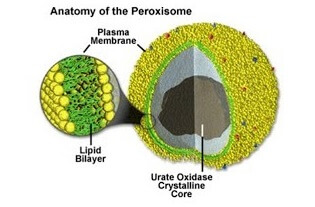Peroxisome
Peroxisome is a microbody. There are two types of microbodies that include peroxisomes and glyoxysomes. Peroxisomes are single membrane bound structures and are similar to lysosomes in structure and function. The term ‘microbodies’ was introduced by Rhodin in 1954.
Peroxisome was discovered by Christian de Duve and co-workers. However, it was seen for the first time by Rodin in the liver cells and kidney cells. It is named peroxisome due to the formation of hydrogen peroxide inside it. Peroxisomes are found in eukaryotic cells and in plant cells. In invertebrates, it is found in paramecium.
Number of peroxisomes per cell
The number and size of peroxisomes vary from cell to cell depending on the type of cell and environmental conditions. For example, in baker’s yeast small number of peroxisomes are found when glucose is supplied to the yeast. On the other hand, there can be up to 25 peroxisomes in baker’s yeast when it is given long chain fatty acids as the only source of carbon. Similarly, there can be 70 to 100 peroxisomes in a liver and kidney cell.
Origin of Peroxisome
It originates from the endoplasmic reticulum (ER) as they are extensions of ER that bud off to form vesicles called peroxisomal precursor vesicles. These precursor vesicles take enzymes and nutrients from the cytosol and thus become peroxisomes. The peroxisomes may increase in size and divide into two if they have enough amount of protein and phospholipid material that they receive from cytosol and the endoplasmic reticulum.
Structure of Peroxisome
It is a single membrane bounded cell organelle, which may be spherical or oval in shape.

Its diameter ranges from 0.1 to 0.5 micrometre and its membrane is a lipid bilayer like a plasma membrane. Its main role is the formation and breakdown of hydrogen peroxide. Besides this, it has a crystalline core as it has Urate oxidase present at the centre in crystalline form.
How does Peroxisome work?
During the metabolism or break down of proteins along with useful products various harmful substances are also formed such as urea, uric acid, and access amino acids. Peroxisomes allow these harmful substances to move into it.
It has two types of enzymes. One is oxidase and another one is catalase. The oxidase (peroxidase) enzymes include D-amino acid oxidase, alpha hydroxy acid oxidase, and beta hydroxy acid oxidase. Peroxisome performs the oxidation of uric acid, urea, etc., in the presence of oxidase enzyme and forms hydrogen peroxide and hydrocarbon is released. In this process, the oxidase enzyme removes hydrogen from the substances and adds it to oxygen to form hydrogen peroxide. For example; RH2 + O2 → R + H2O2 (where R is an organic substrate)
The hydrogen peroxide is not good for the cell due to its corrosive effect. So, it is required to be removed immediately. The second enzyme catalase converts this hydrogen peroxide into water and oxygen, which are non-toxic substances and thus the cell is protected. For example; 2H2O2 → 2H2O + O2
So, it degrades the reactive oxygen species (ROS) that can damage the cell. ROS such as oxygen ions or peroxides are produced as a by-product of normal cellular reactions and due to tobacco, radiations, and drugs. ROSs cause oxidative stress which can damage DNA and molecules made of lipids like cell membranes. Antioxidants are also used to prevent this.
It also carries out the breakdown of fatty acid like oil molecules to produce energy. Besides this, like lysosomes, peroxisomes also contain enzymes. However, unlike the lysosome which mainly breaks down proteins, the peroxisome mostly breaks down long fatty acids, a process called lipid catabolism.
Functions of Peroxisomes
- They are responsible for removing toxic substances from the body.
- They convert uric acid, amino acid, into hydrogen peroxide and change hydrogen peroxide into oxygen and water to protect the cells from the harmful effects of hydrogen peroxide.
- It detoxifies the alcohol and drugs in the liver by removing hydrogen from alcohol and adding it to oxygen.
- In plants, photorespiration occurs in peroxisomes present in the plant cells.
- In the presence of oxygen, it converts fatty acids into smaller molecules.
- They are involved in lipid metabolism such as beta-oxidation of fatty acids, biosynthesis of cholesterol, and synthesis of steroid hormone, etc.
- They also take part in the catabolism of D-amino acids, bile acids and polyamines.
- Peroxisomes present in green leaves aid in photosynthesis. They carry out photorespiration along with chloroplasts.
- It supports the germination of seeds. It converts the stored fatty acids to carbohydrates and thus provides energy and raw materials for the growth of germinating plants.
- It also contains enzymes to make plasmalogens that are an important component of the membrane of brain and heart tissues.
- Peroxisomes in fireflies contain luciferase enzyme that aid in bioluminescence and thus helps fireflies find their mate.
- It helps in the synthesis of phospholipids that are needed in the cell membrane.
- They contain oxidising enzymes that aid in the process of gluconeogenesis (formation of glucose) in animal cells.
- In leaves, they take part in the photorespiration and are involved in the oxidation of glycolates that are formed in chloroplast by photosynthesis.
- It breaks down the Hydrogen Peroxide (H2O2), which is formed during photorespiration, into water and oxygen with the help of catalase, so it protects the cell from the toxic effect of hydrogen peroxide.
- The enzyme urate oxidase take part in the catabolism of amino acids, polyamines and purines (nitrogenous bases found in nucleic acids like DNA and RNA).
